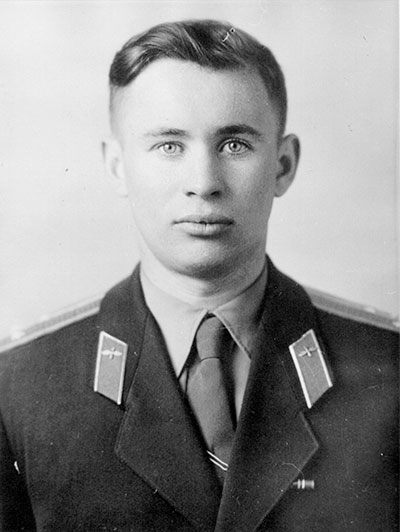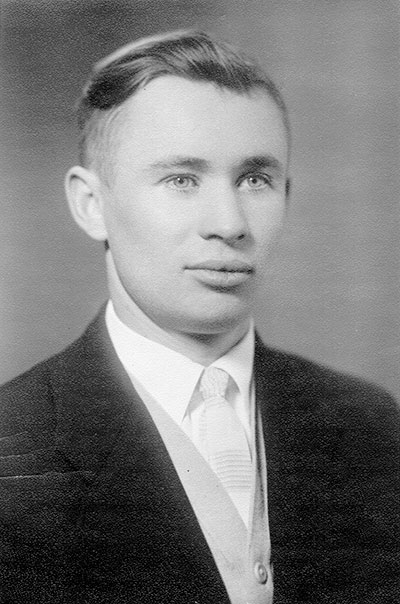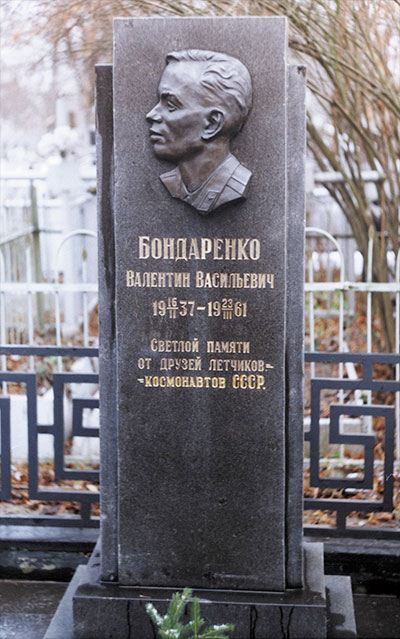On March 23, 2021 is the 60th anniversary of the death of Valentin Vasilievich Bondarenko.In April 1986 four issues of the all-union newspaper Izvestia published a series of articles by journalist Yaroslav Golovanov, from which readers learned that twenty candidates had been selected for the first human spaceflight. Yuri Gagarin and eleven of his comrades succeeded in becoming conquerors of the universe, while the fate of the other eight did not smile. One of those eight was Valentin Bondarenko.
Who was Valentin Bondarenko?

Valentin Bondarenko was born on February 16, 1937, in Kharkov. In May 1954 Valentin successfully graduated from the secondary school and at the same time graduated from the Kharkov regional flying club.
In September 1954, Valentin Bondarenko became a cadet of Voroshilovgrad aviation school. In 1955 some of the cadets were transferred to Grozny aviation school.
In 1956 Valentin Bondarenko married his coeval Anna Rykova, and that year she gave him a son. The boy was named Sasha.
In 1957 Valentin successfully graduated from the military college. He was directed to the Baltic republics. There Bondarenko served till 1960.

In 1959 Valentin was offered to pass a medical commission to the cosmonaut corps. On May 31, 1960 senior lieutenant Valentin Vasilievich Bondarenko was enlisted in the military unit No. 26266 in the suburbs of Moscow. This five-digit number stood for a small military town, where the first twenty future cosmonauts - those who today are called "Gagarin's squad" - trained.
Tragedy during testing
Future cosmonauts were seriously prepared for space flight. One of the preparations was an experiment in the surdobar chamber of the Air Force Research Institute-7 (now the Institute of Aviation and Space Medicine). It was designed to conduct long (10-15 days) physiological, psychological experiments and other studies with candidates for astronauts. Moreover, these tests were performed under strict isolation of the subjects and under alternating pressure.
Valentin Bondarenko was to begin tests on March 13, 1961. He was by no means the first of his fellow cosmonaut candidates to undergo this training - before Valentin, sixteen of his comrades successfully managed to "sit out" in the "surdobaro". Valentin Bondarenko was given tests in the inverted mode of the day: during the day he had to sleep (from 14 to 23 hours), at night he had to stay awake and keep watch.
Tragedy struck on the tenth day. Let us give the floor to journalist Yaroslav Golovanov:
Valentin Vasilievich Bondarenko, a military pilot, died. It happened on March 23, 1961. Valentin was the youngest member of the first group of cosmonauts (he was 24 years old). According to the training schedule, on that day he was finishing his ten-day stay in the surdobar chamber - like other cosmonauts, he was tested by solitude and silence. The pressure in the surdobar chamber was low, which was compensated for by excessive oxygen. Having removed his sensors after medical tests, Valentin wiped the places where they were attached with a absorbent cotton soaked in alcohol, and without looking, threw this absorbent cotton, which fell on the spiral of an electric stove that had been switched on. In the oxygen-saturated atmosphere the flame instantly engulfed the small space of the surdochamber. Valentin's wool training suit caught fire, but he did not signal the alarm to the console, trying to knock down the flames himself. The doctor on duty could not open the sealed door immediately without equalizing the pressure outside and inside. All this required extra seconds. And there were none. When Valentin was pulled out of the surdochamber, he was still conscious and kept repeating: "It was my fault, don't blame anyone..."
From this description of the tragedy it follows that Valentin Bondarenko died because of his own mistake - he did not look where he was throwing, he threw a cotton ball soaked in alcohol, and the cotton ball fell on the electric stove. Moreover, Valentin did not sound the alarm and tried to extinguish the flames himself, which led to a delay in the rescue operation. That is, three consecutive mistakes allegedly led to the astronaut candidate's death.In 1984, St. Martin's Press published a book with the title "The Russian Doctor" written by Vladimir Golyakhovsky, a surgeon who had emigrated from the USSR. He described the death of a trainee cosmonaut in a barometric chamber fire. The incident took place in Moscow's Botkin Hospital. Botkin Hospital in Moscow, where Golyakhovsky worked in the emergency surgery department and where the dying cosmonaut was delivered.
As Golyakhovsky recalls, this very badly burned man was brought on a stretcher. "I couldn't contain my trembling," Golyakhovsky continues. - The whole man was burned. His body was completely devoid of skin, his head of hair, and there were no eyes visible on his face. ... It was a solid burn of the highest degree. But the patient was still alive..."
Golyakovsky noticed that the man was trying to say something and leaned in to hear. "It really hurts, please do something to take the pain away," were the only words he could make out.

Valentin Bondarenko was buried in the city of Kharkov in the Filippovsky cemetery. After Yuri Gagarin's triumphant flight into space, the Soviet leadership generously rewarded everyone involved in the enormous accomplishment. By the decree of Presidium of the Supreme Soviet of USSR from June 17, 1961 senior lieutenant Valentin Vasilyevich Bondarenko (posthumously) was awarded the Order of the Red Star for successful fulfillment of the government`s task.
Questions and versions
The version of Valentin Bondarenko's death, given in articles by Yaroslav Golovanov and then in his book "Cosmonaut №1", since spring 1986 is reproduced in tens and hundreds of publications on the history of cosmonautics. But is it true?
Doctor Vladimir Golyakhovsky states that Valentin Bondarenko was taken to the emergency room of Botkin hospital while he was on duty on March 22, 1961. The cosmonaut candidate died the next day by morning, sixteen hours after being brought to the hospital. It follows that the tragedy in the surdobarochamber happened not on March 23, 1961, as Yaroslav Golovanov wrote about it, but a day earlier - March 22, 1961, around noon.
Valentin Bondarenko, fatally burned, was dragged out of the surdobar. He is in hell of pain, his eyes and upper respiratory tract may have been damaged. But he finds the strength to tell the prehistory of the tragedy and repeats several times - so people around him will understand and remember it well - "It's my fault, don't blame anyone...".
This phrase is extremely interesting by its very content. It is as if Valentin is trying to protect someone from sweeping accusations. Whom, exactly? Yaroslav Golovanov says that "doctor on duty immediately open the airtight door, without equalizing the pressure outside and inside, could not. All this required extra seconds. And there weren't any. What can you blame the doctor on duty? If the door could not be opened immediately due to the pressure drop, what was the fault of the doctor on duty? After all, he raised the alarm, and rescuers "pulled out of the surdochamber" Valentin Bondarenko. That is, the doctor acted correctly. Maybe there was someone else who could have been punished for some omissions in the preparation of the trials in the surdochamber?
Alas, there is no information that any governmental or interdepartmental commission was organized to investigate the cause of the tragedy. The investigation was conducted only within the Institute of Aviation and Space Medicine itself. In an April 21, 1961 entry in his diary, General Nikolai Kamanin, mentor of the first cosmonaut detachment, testifies:
"Tonight the Military Council of the Air Force met, heard the report of Major General A.N. Babiychuk on the causes of the death of the cosmonaut trainee V.V. Bondarenko. He was the seventeenth in a 15-day test in the hyperbaric chamber. On the tenth day, while heating food on the electric stove in the pressure chamber a fire broke out, and Bondarenko died from severe burns".
So this is the official version of the cause of death of candidate to cosmonaut Valentin Bondarenko. And it does not mention any medical procedures, neither the absorbent cotton soaked with alcohol, which the cosmonaut candidate allegedly threw into the trash basket without looking, but got on the open spiral of the electric stove. There is nothing in this version about the fact that Valentin did not sound the alarm in time and tried to extinguish the fire in the surdochamber. Most likely Valentin Bondarenko was going to have dinner, as he lived on an "inverted" schedule and had to sleep from 14 to 23 hours. The cause of the fire while heating food could have been anything. For example, a short circuit in the electrical system - and not necessarily on the stove itself.
Both the official version (from the report of major-general Babijchuk) and the most widespread one (from the articles of journalist Golovanov) are based only on information about the event, received from the staff of Institute of aviation and space medicine. But how complete is this information? Can it be fully trusted?
Testimony of test tester Nefedov
Since both versions are based on the stories of employees of the Institute of Aviation and Space Medicine, we will allow ourselves to cite another story, also told by Sergey Pavlovich Nefedov, an employee of the Institute of Aviation and Space Medicine:
"The Americans' Mercury ship was on oxygen, and our Vostok ship was in a normal Earth atmosphere. But ours needed to know what would happen if the ship had pure oxygen. Valentin Bondarenko had training - to sit in a surdobar chamber at 5,000 meters altitude (i.e. simulating pressure that happens at 5,000 kilometers above sea level - S.Ch.) in an atmosphere with seventy percent oxygen.
He died due to oversight of engineers. We have a duty doctor and a mechanical engineer on duty near the pressure chamber, and a laboratory assistant constantly looks out the window and writes in the logbook what the tester is doing.
At that moment the mechanic on duty was away, he went for lunch, to get something to eat. Valentin was also going to eat, he turned on the stove to heat something up. Then the doctor asks him to get ready to record a cardiogram, to put sensors on himself. Valentin takes a absorbent cotton soaked in physiological solution with alcohol, wipes himself and drops the absorbent cotton on the stove. The tile bursts into flames. Everything flares up. In an atmosphere full of oxygen, even metal was on fire!
The doctor and the lab assistant were running around, but they couldn't open the chamber. They do not know where to press to release pressure. Valentin could have been saved if there had been a mechanic nearby, who would have depressurized the inside of the pressure chamber.
Note that in the story of test person Nefedov there is not a single word about the fact that Valentin Bondarenko did not give the fire alarm signal to the console in time, there are no words attributed to the injured candidate for cosmonauts: "It is my fault, do not blame anyone...". It is clear that death of Valentin Bondarenko was not so much the result of his own mistakes but rather the consequence of outrageous violations of safety rules by those who planned the experiment and monitored its progress. The only thing Valentin Bondarenko can be accused of is inadvertently dropping an alcohol-soaked cotton wad on a switched-on electric stove. But did Valentin really drop the notorious absorbent cotton? Did the absorbent cotton arise during the investigation simply to cover up someone else's criminal negligence? These questions remain open to this day.
What really happened
It is obvious that there were violations of safety rules by those who planned the experiment and monitored its implementation.
First of all, in an oxygenated atmosphere it is unacceptable to use an electric stove. This means that the experiment managers should have provided other options for heating food for the cosmonaut candidate while he was "sitting" in the hyperbaric chamber.
Secondly, the shift on duty was not prepared to act in an emergency situation. Physician and laboratory assistant were not prepared for the conditions of emergency evacuation of the test person from the surdochamber.
Third, the work of the on-duty shift was improperly organized, since the operators (in this case, the mechanical engineer) were allowed to leave the test site without appropriate equivalent replacement.
Fourth, the doctor on duty made a mistake by deciding to combine preparation for lunch (with the electric stove on) by the cosmonaut candidate with medical procedures.
Fifth, the institute during dangerous experiments did not have a full-time emergency rescue team, which could have come to the rescue immediately if the doctor on duty or the tester had sounded the alarm.
In fact, General Nikolai Kamanin came to the same conclusion in his diaries:
On March 23 (1961 - S.Ch.).
The cause of the fire is still unknown, most likely due to poor organization of watch and control over the tests.21 April.
...Bondarenko died because of severe burns. His death revealed serious flaws in the organization of tests at the Institute of Aviation and Space Medicine.
One of the books on the history of Soviet space medicine has these lines: Tragedy (with Valentin Bondarenko - S.Ch.) was painfully felt by employees of GNIIAIKM and CPC, who, nevertheless, felt their involvement in the accident as well: because there was not a hundred percent need for such kind of training and they were excluded from training tests.
The full picture of the accident in the spring of 1961 is as follows. The newborn space medicine attracted a mass of people who wanted to defend their PhD and doctoral dissertations on topics that fell within the scope of the new direction in science. Alexei Arkhipovich Leonov, a Soviet cosmonaut and twice Hero of the Soviet Union, recalls: A lot of doctors rushed to conduct serious scientific experiments on living material. We (cosmonaut candidates - S.Ch.) were (in the early 60's - S.Ch.) in a regime of a powerless person. That is, we were allowed to do everything what doctors need to do. And there must not be any caprices. To quarrel with the doctors - this is, consider that it was ruined (for the flight into space - S.Ch.).
Using the fact of compulsory training of candidates for astronauts in a surdobarochamber, to the usual tests in conditions of silence and solitude "added" more and tests in air environments with different oxygen content. Since there were no well-designed methods for conducting these "additional" tests, there were numerous facts of gross violations of safety during the work.You should agree that this picture of the tragedy which happened in March 1961 can be called by one word only — a crime...














